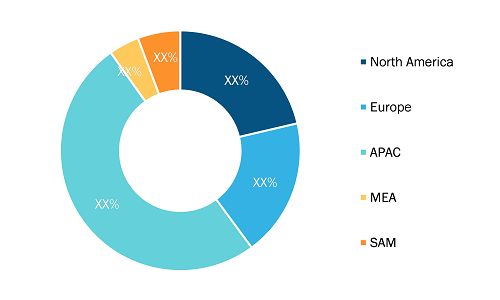The maritime information market size is expected to reach US$ 2,808.87 million by 2028, registering at a CAGR of 6.2% from 2022 to 2028, according to a new research study conducted by The Insight Partners.
Development of Integrated Solutions to Lower Maritime Terrorism and Piracy Provide Opportunities for Maritime Information Market Growth During 2022–2028
Effective real-time information exchange across groups is essential for the maritime sector. The information and communication technology that links all the participants and permits the efficient flow of information, intelligence, and communications is the foundation of the global naval network. Advanced vessel traffic services (VTS), which are commonly deployed by major ports, waterways, and maritime authorities, are also used for incident management and maritime rescue coordination on a large scale. Integrated traffic management systems and solutions provide high performance and dependable services to meet the constantly evolving maritime safety regulations. Incident detection is crucial in the maritime industry. Surveillance equipment such as radar, sonar, AIS, and closed-circuit television (CCTV) is required to provide operators with real-time situational awareness. Therefore, there is a high demand for integrated solutions that would enable data analysis to stop maritime terrorism and piracy, which is creating significant opportunities for the maritime information market growth.
Maritime Information Market — by Region, 2021

Maritime Information Market Key Findings and Share by 2028
Download Free SampleMaritime Information Market Forecast to 2028 - COVID-19 Impact and Global Analysis By Platform (On-Shore and Vessel), Application (Fleet Management, Vessel Tracking, and Maritime Security), and End-User (Commercial and Government)
Source: The Insight Partners Analysis
Digital technologies are being used increasingly in maritime operations, processes, and business models to boost efficiency and security and reduce costs. Digital transformation has become essential for the long-term profitability and competitive advantage of any company. Businesses worldwide are embracing digitization to enhance their internal operations and boost productivity and revenues. The marine industry is also going through a paradigm shift due to changing business models, technology adoption, cost structures, and increased competition. The creation of new business models, digitalization of fundamental processes, and application of analytics for improved decision-making are among the significant aspects of the digital transformation of the maritime sector. Businesses employ maritime information to improve daily activities such as freight routing, cargo handling, port operations, vessel deployment, and empty repositioning. Process improvement, high operational effectiveness, cost cutting, and human error minimization are driving the demand for digital solutions in the global maritime sector. As a result, the demand for digital solutions, such as marine information, is likely to surge in the global maritime sector in the coming years.
Marine management entails all auxiliary services, from crewing and training to procurement and bunkering, to allow marinas to function at sea. Cloud computing facilitates better operations, communications, and collaborations among workforces worldwide. Cloud-based solutions provide access to the most recent solution versions, newest features, and quick support. Cloud-based maritime software solutions enable clients to concentrate on their businesses, address incoming concerns without delays, and automate software version upgrades, along with the benefits of stringent security measures. Companies such as Chetu, RMS, Scribble Software, and Harba provide cloud-based marina management software that automates time-consuming, repetitive operations. Therefore, developments in cloud computing technology are anticipated to drive the adoption of maritime information solutions in the coming years.
Europe is the leading region in the maritime information market share owing to favorable government policies and increasing investment in maritime information projects. Countries such as Spain are among the prominent importer of LNG through ships and long carriers in Europe. In early 2021, the demand for gas in Spain grew by 43% compared to the previous year. This was partly due to above-average summer temperatures and hydropower reserves that were 17% lower than the 10-year median. To fulfill increased demand, Spain ordered an additional 26 LNG carriers. A large part of the rise was attributable to extra Russian tankers, which now account for 6% of Spain's overall gas supply. Hence, the rising purchase of ships and carriers is anticipated to create lucrative opportunities for the maritime information market size over the forecast period.
The maritime information market is segmented on the basis of platform, application, and end-user. Based on platform, the market is bifurcated into on-shore and vessel. Based on application, the market is segmented into fleet management, vessel tracking, and maritime security. Based on end-user, the market is bifurcated into commercial and government.
Thales, Lockheed Martin, Northrop Grumman, L3Harris, and Bae Systems are a few of the key players profiled during this study on the maritime information market. Several other important market players were analyzed during the course of this market research study to get a holistic view of the global Maritime Information market size and its ecosystem.
The COVID-19 outbreak dramatically impacted the global economy in early 2020, and the crisis has hampered business activities in maritime industries. The pandemic caused delays in the flow, storage, and transit of commodities, which negatively impacted the expansion of the logistics & transportation sectors in 2020. The outbreak also disrupted the market player’s competitiveness, labor availability, and economic expansion. During the pandemic, some of the biggest logistical shipping contractors ceased their businesses due to restrictions on foreign trade activities, ship entry and exit, cargo backlogs, and quarantine requirements. As a result, the shipping industry in APAC reduced the need for maritime information systems in the first two quarters of 2020 and witnessed moderate demand in the last two quarters of 2020. China is a significant producer and consumer of goods in several important sectors, including automobiles, semiconductors, commodities, and agriculture. With a few busiest ports, including Shanghai and Yangtze ports, China is one of the key nations in global trade. Further, the growing industrialization is bolstering the maritime information market share as the global economy is gradually recovering from the COVID-19 crisis.
Contact Us
Phone: +1-646-491-9876
Email Id: sales@theinsightpartners.com